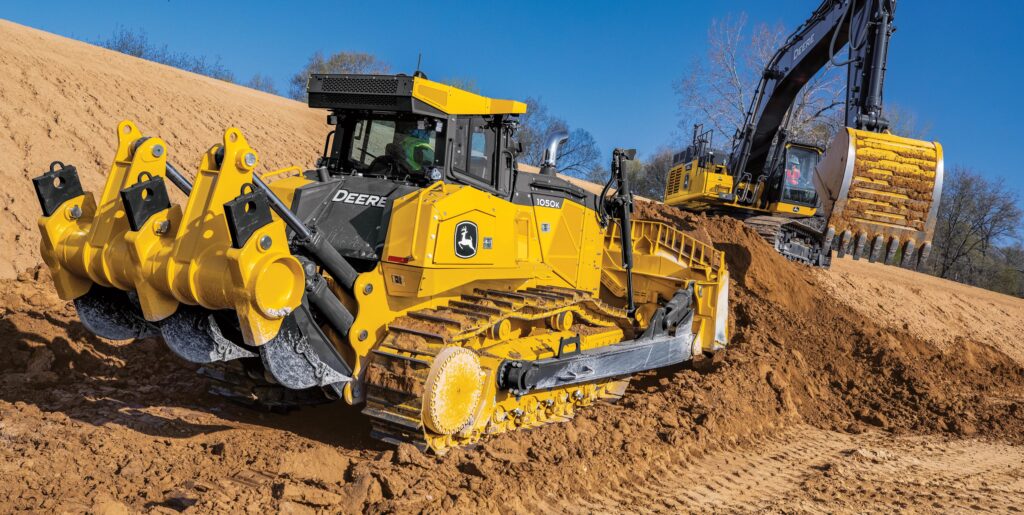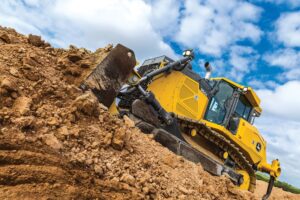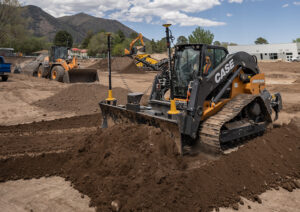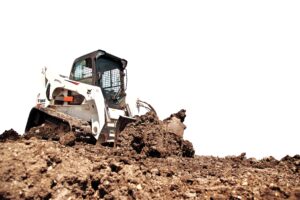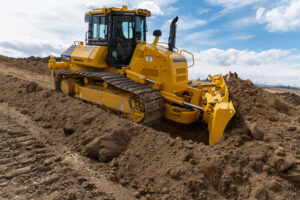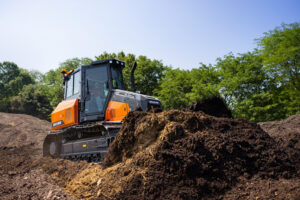
Bullish on moving earth
By NATE HENDLEY
Construction Equipment Equipment TechnologyBulldozer OEMs add enhancements to boost productivity, lower costs, and enable ease of use.
OEMs continue to add high-tech features and make structural changes to their bulldozers as they aim to enhance performance and reduce costs. In short, dozers are becoming increasingly powerful, productive and connected, while cabs are safer and more comfortable than ever.
For all that, some common vehicle trends, such as electrification and automation, remain a challenge when it comes to dozers. This has less to do with technology than with concerns about safety and practicality within the construction sector.
Driverless trucks are used to haul loads in some mines, but these vehicles operate in controlled environments away from the public. Putting automated dozers on worksites in population centres raises a fear of malfunctioning machines plowing into homes, schools and roads, which is difficult to overcome. Driverless dozers would need to demonstrate flawless performance and a perfect safety record to gain mainstream acceptance at worksites in populated areas.
Dozer electrification also poses challenges. While the concept isn’t new — Caterpillar unveiled the Cat D6 XE, which the company described as “the world’s first high drive electric drive dozer” back in 2019 — charging concerns persist.
“While electrification of utility equipment has its advantages due to ease of transport to energy sources, larger equipment poses a challenge because of the demanding duty cycles and availability of power sources in remote locations,” states Rafal Bukowski, product specialist, for HST Dozers at Komatsu. “At Komatsu, we are focused on finding solutions that both meet our customers goals and our carbon neutrality goals, which means looking at various solutions depending on the size of the equipment and application.”
For all that, no one in construction should dismiss the notion of driverless or large-sized electric-battery dozers. Pundits from decades past, after all, never would have predicted that remote monitoring and digital file sharing would become common dozer features.
“‘Autonomy’ and ‘electric’ are words that are swarming around the construction industry. At John Deere we are focused on making our machines smarter, safer, and more sustainable to keep the construction industry moving forward. Autonomy and electric will obviously play a large part in that, and there will likely be steps in-between to get us there,” notes Matt Goedert, solutions marketing manager at John Deere.
JOHN DEERE
Over the past two years, John Deere has made multiple productivity-enhancing upgrades to its dozer lineup.
Blade offerings, undercarriages, and exterior hoses have all been upgraded on large 950K and 1050K dozers, for example. Both machines now feature an extended life undercarriage option that uses a proprietary coating it says doubles the working life of standard track chain bushings. The 1050K was fitted with a suspended double-bogie undercarriage frame that provides a more comfortable ride on rough terrain.
“These updates centred around making the machine more productive and reducing potential for downtime. Along with increased productivity, operators are enjoying the smoother ride of the updated 1050 undercarriage,” says Goedert.
John Deere has also expanded the number of dozers fitted with Slope Control, an entry-level solution that makes it easier to grade smooth planar surfaces in applications like road building. Slope Control is now optional on John Deere’s 450, 550, 650, 700, 750 and 850-size dozers, while a “SmartGrade Ready” feature is also available on the latter four models.
SmartGrade Ready “gives customers flexibility. If they want to upgrade to SmartGrade down the road, the harnessing is already installed on the machine making it a faster turnaround time to install the upgraded technology,” explains Goedert.
Another solution, SmartGrade Remote Support, is now standard on the company’s 650, 700, 750, and 850 dozers.
With features such as Remote Display Access (RDA) and Wireless Data Transfer (WDT), SmartGrade Remote Support “allows users to remotely troubleshoot issues to reduce downtime and transfer files to/from the machine,” explains Goedert.
CASE
Case Construction Equipment recently unveiled the Minotaur DL550 compact dozer loader, an industry first-machine that the company says is, “Part dozer. Part loader. All beast.”
The DL550 “delivers true dozing performance and true compact track loader performance … You can use it in the dozer configuration with the integrated C-frame and six-way blade,” states Jeff Jacobsmeyer, product manager at CASE Construction Equipment.
Putting dozer and loader capabilities in a single compact machine reduces both worksite congestion and costs for owners, he adds.
Weighing 18,600 pounds, the DL550 is easy to transport, and is suited to jobsites with limited space. Powered by a 114 hp engine, the DL550 boasts adjustable electro-hydraulic controls like Case’s full-size dozers, a true-positive pressure cab to keep out dirt, dust, and noise, and the company’s popular “Blade Shake” feature.
Activated by a joystick button, Blade Shake “hydraulically shakes the blade when you come to the end of a push and it sheds the dirt and material stuck to the blade so that you’ve got a clean blade on the next push,” states Jacobsmeyer.
The DL550 comes standard with Case Universal Machine Control for precision grading, Case SiteWatch telematics and the SiteConnect Module.
“With standard telematics, you can remotely monitor machine performance and activity. With the SiteConnect Module, you can remotely check machine codes, and service needs and upload software updates,” explains Jacobsmeyer.
BOBCAT
Bobcat offers a handy dozer blade attachment for select company skidsteer loaders, compact track loaders and telehandlers.
“While applications can vary, the dozer blade attachment can turn a loader into a mini-crawler for optimal performance on construction and landscaping jobsites,” says Keith Huff, product specialist at Bobcat.
The six-way adjustable blade angles at plus or minus 30 degrees and can oscillate 10 degrees as well. Blades range from 80 to 96 inches in size, while adjustable skid shoes mounted on the attachment control and guide blade depth.
Suitable applications include backfilling around foundations, creating runoff grades, and leveling, piling, or grading loose gravel, dirt, and sand.
“The dozer blade attachment is an excellent option for owners or rental companies that want the functionality of a dozer without the need for a dedicated machine,” adds Huff.
KOMATSU
When Komatsu introduced the D71-24 in early 2020, the company boasted that its new, mid-sized crawler dozer featured the most powerful hydrostatic transmission in its size class. It’s a claim that still holds true today, says Bukowski.
“The D71 is a 237 hp machine … It is the strongest machine in its size class with regards to performance,” he states. The D71-24 has a six-way power angle tilt (PAT) blade pitch system, and is well- suited for grading, side-cutting and pushing.
The D71i-24 version of this crawler dozer (the “i” stands for “intelligent”) features Komatsu’s proprietary, performance- enhancing intelligent Machine Control (iMC) 2.0.
Introduced at CONEXPO-CON/AGG 2020, and now on all intelligent Komatsu dozers, iMC 2.0 is an “evolutionary form of technology” that offers “significant productivity and efficiency improvements compared to conventional grading,” says Bukowski.
Since iMC 2.0 is factory installed, “the customer can purchase the machine and pretty much be ready to go. They don’t need to buy any aftermarket [products] or add-ons,” he continues.
The iMC 2.0 solution contains a slew of features, including Proactive Dozing Control which can boost productivity by 60 per cent compared to other Komatsu models.
Proactive Dozing Control “allows the machine to see where it’s going to make its next move. So, as you are running the dozer, it tracks the ground underneath it … This machine can track over and map where it went last and can tell you, ‘You need to cut from this location,’ or ‘You have to fill this location,’” states Bukowski.
The Lift Layer Control feature, meanwhile, enables operators “to essentially double their production from previous models” by maintaining consistent lift thickness and automatically spreading lift, he adds.
Also new from Komatsu is a 2D laser kit for intelligent dozers featuring a Topcon laser receiver. The kit allows operators to use 2D applications “inside buildings, under bridges, closer to power lines—locations where GPS and GNSS connectivity is either poor or nonexistent,” says Bukowski.
DEVELON (FORMERLY DOOSAN CONSTRUCTION EQUIPMENT)
In 2022, DEVELON introduced its first dozer in North America, the DD100, competing in the 140-hp and under category. The company reports that the DD100 dozer is at the top of its class for operating weight and horsepower, adding that the machine is ideal for residential and light commercial construction and fine grading tasks.
“The under 140-horsepower size class presents the biggest opportunity for DEVELON, based on North American dozer sales volume,” says engineering manager Moo Young Park.
Customers can choose from two blade options, a standard 2.9 cubic yard blade or an optional 3.4 cubic yard capacity blade. The blade moves freely to lift, tilt and angle, and offers two-way mechanical adjustments to change the blade pitch to control how steeply the blade will dig into the ground. Operators can adjust the blade pitch from 54 to 58 degrees. Also available is a blade shake button for operators to quickly remove materials stuck to the blade.
DEVELON plans to offer a larger model, the DD130, in North America as well. The company says it expects the 13-metric-ton model to launch in 2023 and be on display at this year’s CONEXPO-CON/AGG in Las Vegas.
Nate Hendley is a freelance writer and author, and is a regular contributor to On-Site Magazine.

